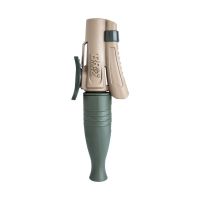
Aerial scouting has become a large part of a whitetail hunter’s game plan for finding new land and expanding their current areas. Still, it can be overwhelming to figure out how to shrink a giant tract of public land to a manageable size for actual hunting. You can learn effective ways to e-scout thanks to all the helpful information available online, but wouldn’t it be great to have just one factor to decide whether an area is worth exploring?
Habitat Diversity Seeking out habitat diversity is a quick and easy way to find key areas. Look for different types of trees and cover, thick vegetation and open space. These spots typically have healthier, older deer due to the various food sources and security cover.
Habitat diversity depends on the region. In farm country, you might find a mixture of agriculture fields, hardwood forests, conifer stands, and hayfields. The big woods can include spots connecting timber cuts, hardwood stands, grassy fields, swamps, laurel thickets, and stands of conifer trees. An old-growth forest is a good example of an area that is not as diverse: The large trees in unlogged old-growth tend to drown out the sunlight, reducing the opportunity for new growth to sprout, creating browse and cover for deer.
This variety in a landscape creates more opportunities for deer to find food and places to hide. These areas provide ample amounts of food for deer in the form of grasses, new growth twigs and leaves, briars, and other vegetation depending on the time of year. The more food and cover available year-round, the healthier the deer will be, and the older they can grow.
Locating Habitat Diverse Locations The best way to locate habitat-diverse locations with aerial scouting is to use a mapping app with both winter and spring imagery. When the leaves are off the trees it’s much easier to see the defined edges of timber cuts, conifer stands, laurel thickets, and hardwoods. Summer imagery can still help you find edges in crop fields, hayfields, and other types of vegetation, but the leaves make it difficult to see these details.
Nothing beats boots-on-the-ground scouting, though. You’ll undoubtedly be able to locate minuscule habitat changes and examples of diversity if you get into these areas and walk them. I typically stick to scouting the edges rather than diving in deep, because deer love edges and will typically use them to lay down sign. If you walk the edge of a mature logging cut you’ll see big rubs and scrapes that could signify that a buck is living around that thicket and coming out to the oak flat for his primary food source.
How to Hunt These Areas The magic happens around the edges of these habitat areas. Bucks won’t walk through the thickest cover every day if they don’t have to. They want to stick to the edges where they can dive into that thick cover if they detect danger. There are a few things to look for when setting up on these transition zones that will help increase your odds of actually getting a shot opportunity.
- Locating where at least three different habitat types meet will increase your chances of seeing deer movement.
- Focus on the inside corners of these habitat types, specifically on the downwind side of thicker ones.
- Let the sign tell you where the deer are frequenting. Community scrapes are excellent ambush sites.
- Always be able to shoot into the thick cover. Although the deer like to run the edge, many older age-class bucks like to stay just inside that thick cover during daylight hours.
- Combine habitat and terrain diversity to funnel deer movement. Edges between terrain features and different habitat types should give you the feeling of that “lightbulb moment."
Many features are important to focus on when searching for the ideal hunting area. Just don’t overlook one of the most critical land features for whitetail hunters. With habitat diversity at the forefront of your mind, you’ll get in the right zone to find the deer you're looking for.
Featured image via Matt Hansen.






